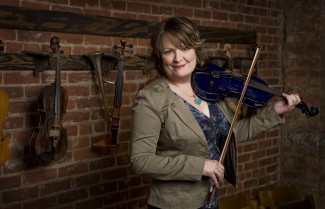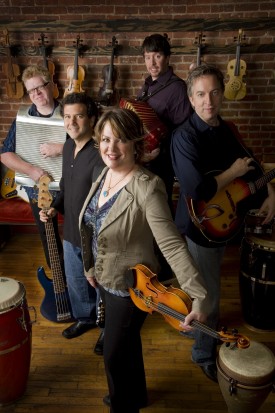INTERVIEW: Retracing the steps of Irish immigrants, one fiddle at a time

Accomplished Irish fiddler Eileen Ivers is set to bring her celebration of the Irish immigrant experience to the State Theatre in New Brunswick, N.J. On Feb. 28, audiences can expect to hear rhythmic stories of Ireland and the strong diaspora of people who have brought the musical traditions of the Emerald Isle far and wide.
For Ivers, it all began in a place familiar to many Irish-Americans in the Northeast: the Bronx.
“Both my parents came from Ireland and settled in New York in the Bronx,” Ivers said recently in a phone interview. “So, yeah, it was kind of like so many immigrants. They wanted their children to take something up of, you know, the Irish culture, and my sister took Irish step dancing. I tried it for about two weeks, and I just begged my mom to please let me move on. But the fiddle was always something that I actually did gravitate to when I was around 7 or 8 years old, and eventually we were really lucky because there was a wonderful Irish-born gentleman in the area who taught. So I started lessons about 8 years old.”
Ivers’ teacher would offer lessons on everything from the fiddle to the accordion to the flute to the whistle, all traditional Irish instruments. She would meet with the other pupils in the back of an Irish club on Bainbridge Avenue.
“It was great because he’d have, I don’t know, maybe 20 kids sort of lined up in two rows of chairs,” she said. “[He would] point to each child, and they would play a tune. And he would somehow, amazingly so, just get the essence of the music and the spirit of it across to the kids. And it was great. You felt a part of this community, and you were immersed in your heritage. But, of course, you were still very much American, so it was great.”

Her love for the fiddle continued as she grew up and went to college. It wasn’t until graduate school that the musician realized maybe she can make a career out of the instrument. “So it eventually just hit me that, hey, I guess I’ll never get that day job,” she said. “So that was kind of when it kind of clicked, probably specifically when I was in Riverdance. And I was touring with that company for about three years, and I really saw the power of music touching so many audiences around the world.”
Today, Ivers tours the world offering unique interpretations of traditional Irish songs. For many of her concerts, she’s joined on stage by her band and Irish dancers. For the State Theatre show, audiences can expect some toe tapping along with the notes coming from Ivers’ fiddle.
“You are carrying, you know, the tradition on your shoulders in many ways, and I want to always represent that in a truthful manner and not really dilute the essence of the music, which is very, very important to me,” she said. “Traditionally an Irish fiddle player might just sit in a circle of players, put the head down and just play as a social manner — you know, to express oneself, to carry on the music, just live it through a social way. But performing is obviously, I always have felt, a tremendous privilege. I think the band and I, I would like to think we really strike very good balance in the passion we feel and the music.”
On stage, Ivers is known to improvise, and she constantly looks to educate the audience on the profundity of the Irish immigrant experience. Her new record, Beyond the Bog Road, references a little road that leads into the ancient peat fields of Ireland, fields where her father and grandparents toiled away. This road, so real and so metaphoric, led Ivers’ parents to the shores of the United States and other immigrants across the world. With their traveling shoes, they carried their instruments, clutching them with pride.
“We talk about things that have impacted the Irish experience from, of course, the famine in 1840s that was just so horrific a time period but led to so much immigration, and the nature of the music and the dance of those years, how it really integrated with other roots music along the way,” she said. “We touch the Appalachian nature of the music and bluegrass, which is an extension of Irish music and African rhythms and, of course, the African banjo. And it’s fun. The show has a nice balance, and the record too, of vocals as well as instrumental pieces that kind of showcase all of that, as well as a Cajun tune that I wrote.”
One highlight of the State Theatre concert may be a Louis Armstrong song called “Irish Black Bottom” where the famed New Orleans singer references the black bottom, a rival dance to the Charleston. Ivers plans to include her unique interpretation of the song in the setlist.
“That’s always a fun thing to meet new friends of the music and folks who will follow you down the road,” she said. “It’s not just a traditional Irish music show.”
For audience members, it may be easy to transport themselves to the musical pubs of western Ireland. Interestingly, Ivers, who also plays in Ireland, can see parallels in the reverse direction. “If you sit in a pub in the west of Ireland you might hear an old-time American tune sit right beside a 200-year-old Irish reel. It’s pretty interesting. They really, I think, have come to feel a lot of pride that the people were so resilient and the music has mixed and has really impacted so much music in the world.”
Ivers called Ireland a “small island of very passionate, musical and poetic people.”
“It’s why the music is so strong, has survived for so many years,” she said. “I think it’s up to us all to keep it going in its pure way as well as in new ways.”
By John Soltes / Publisher / John@HollywoodSoapbox.com

